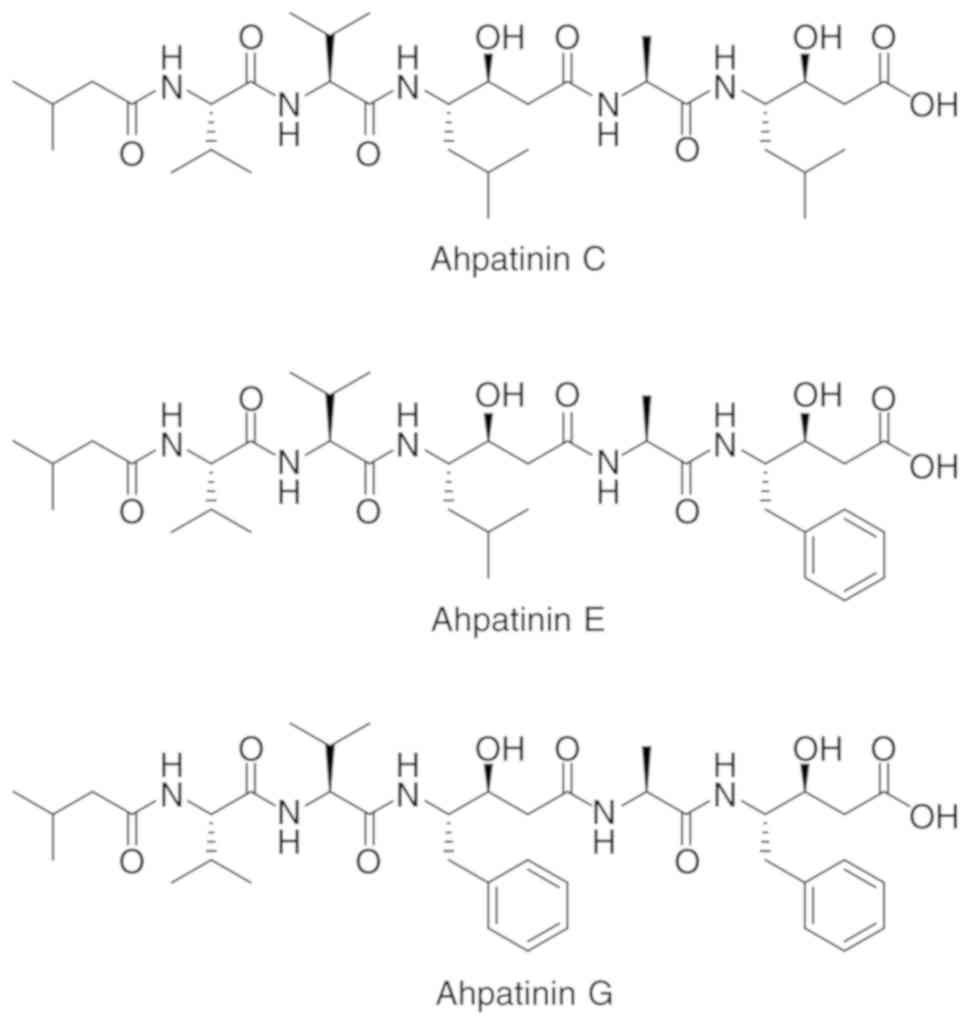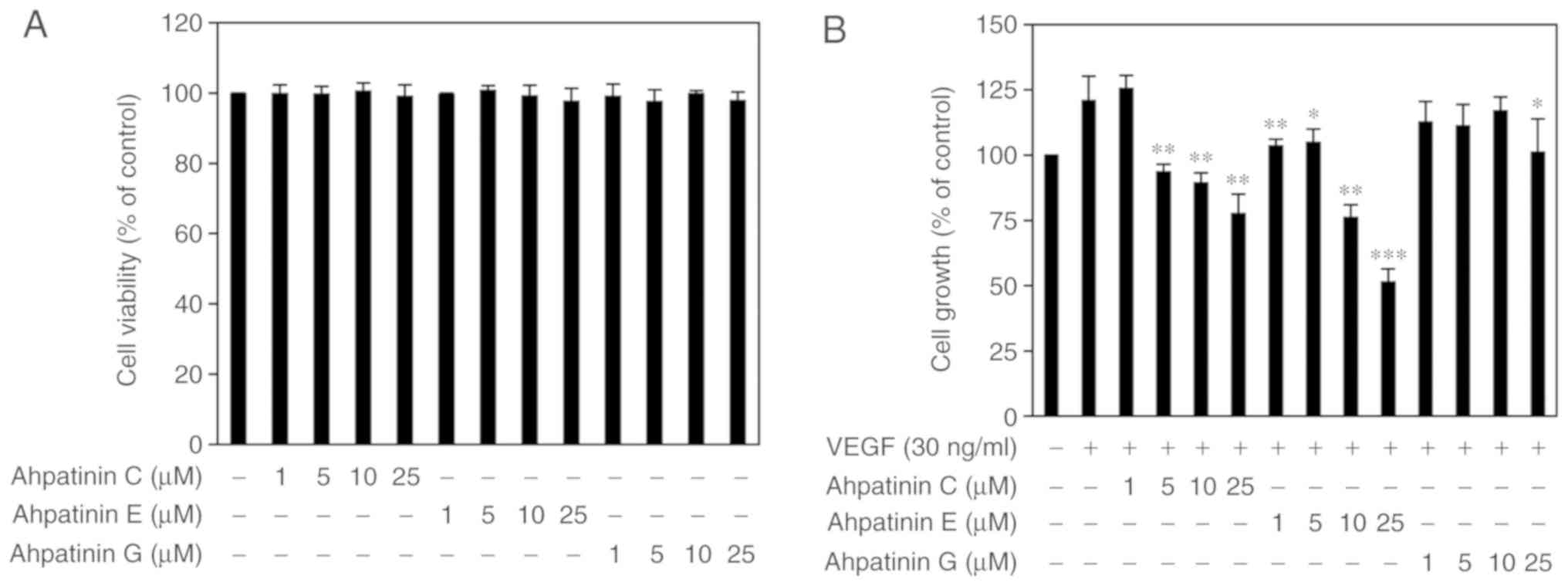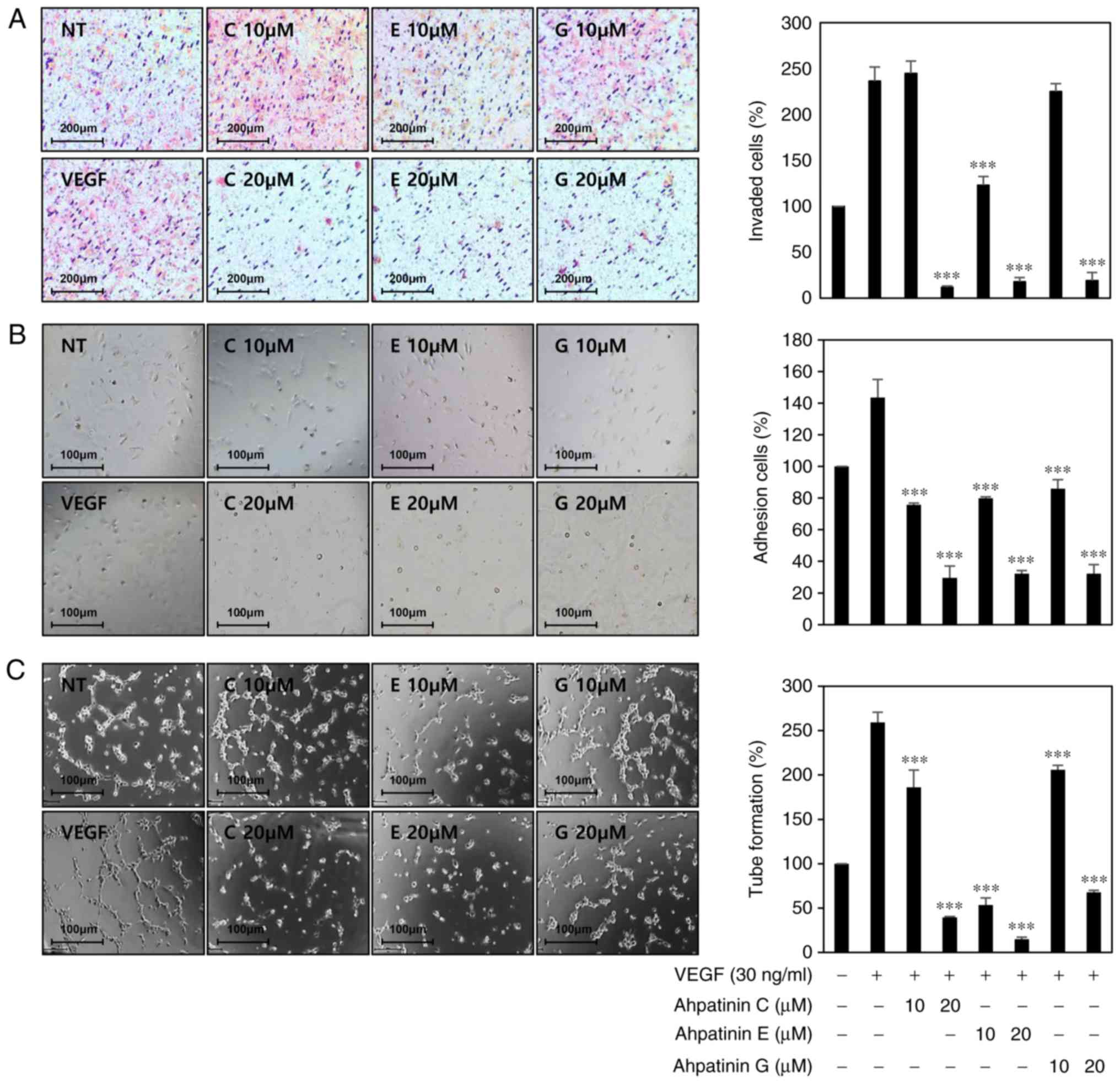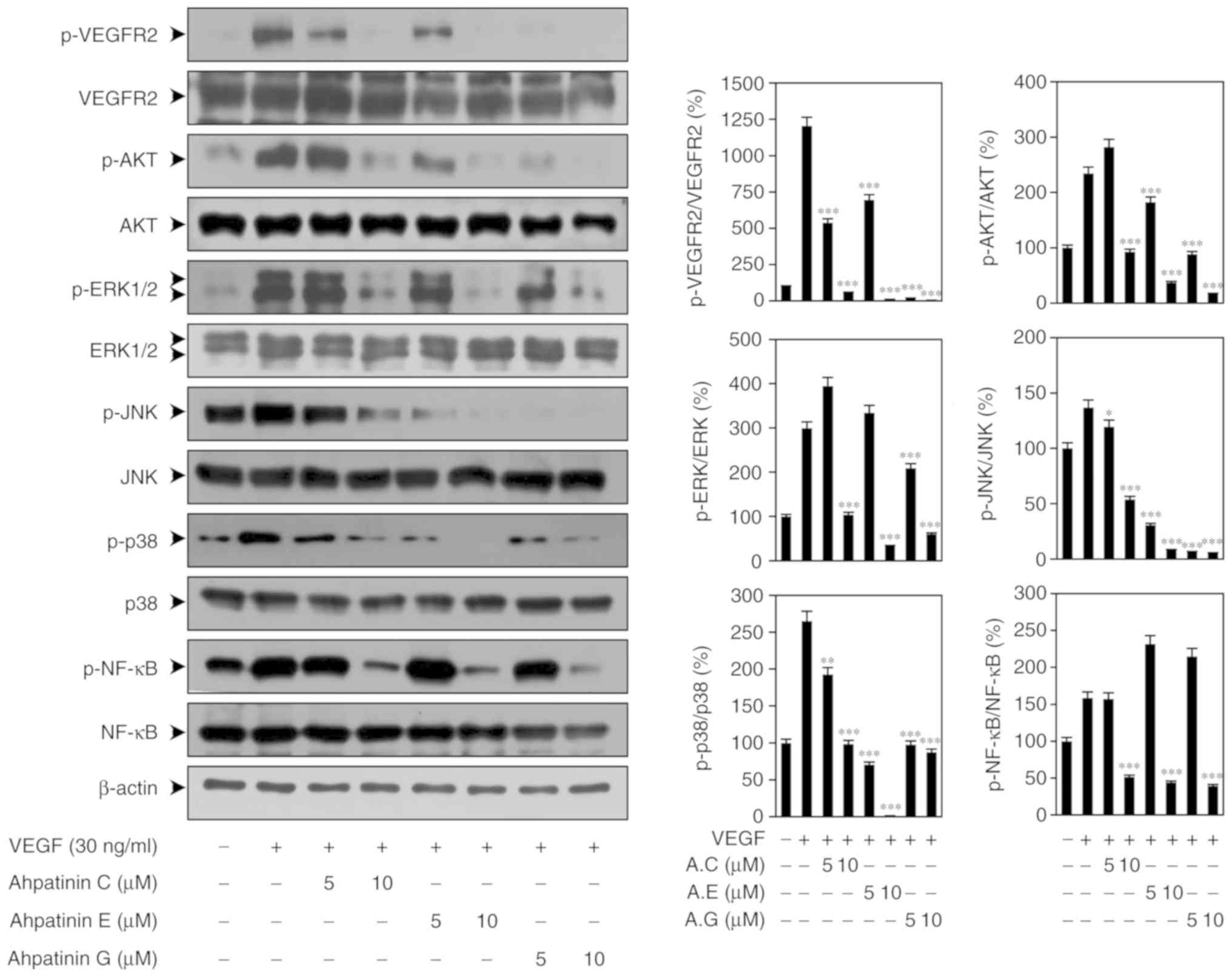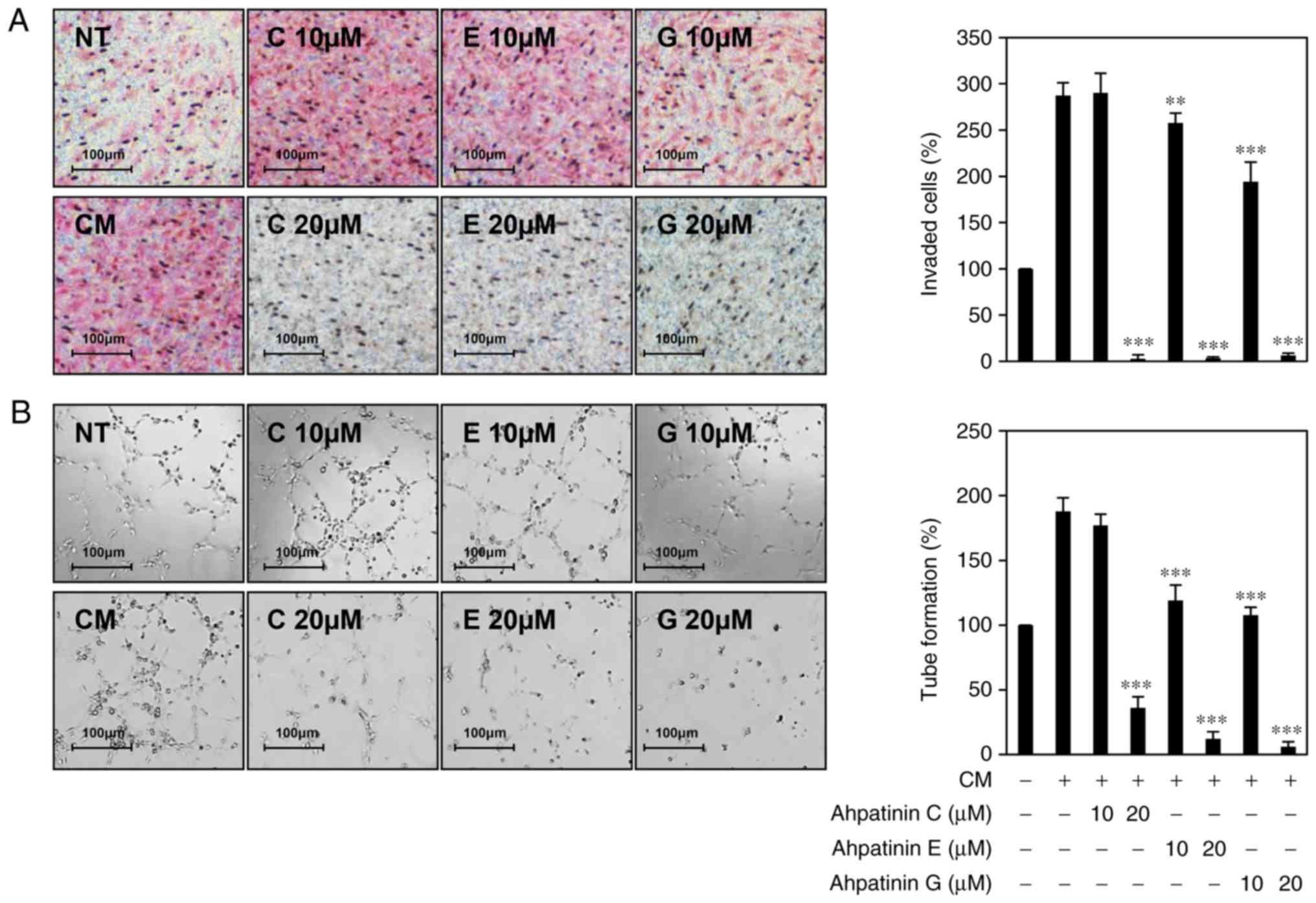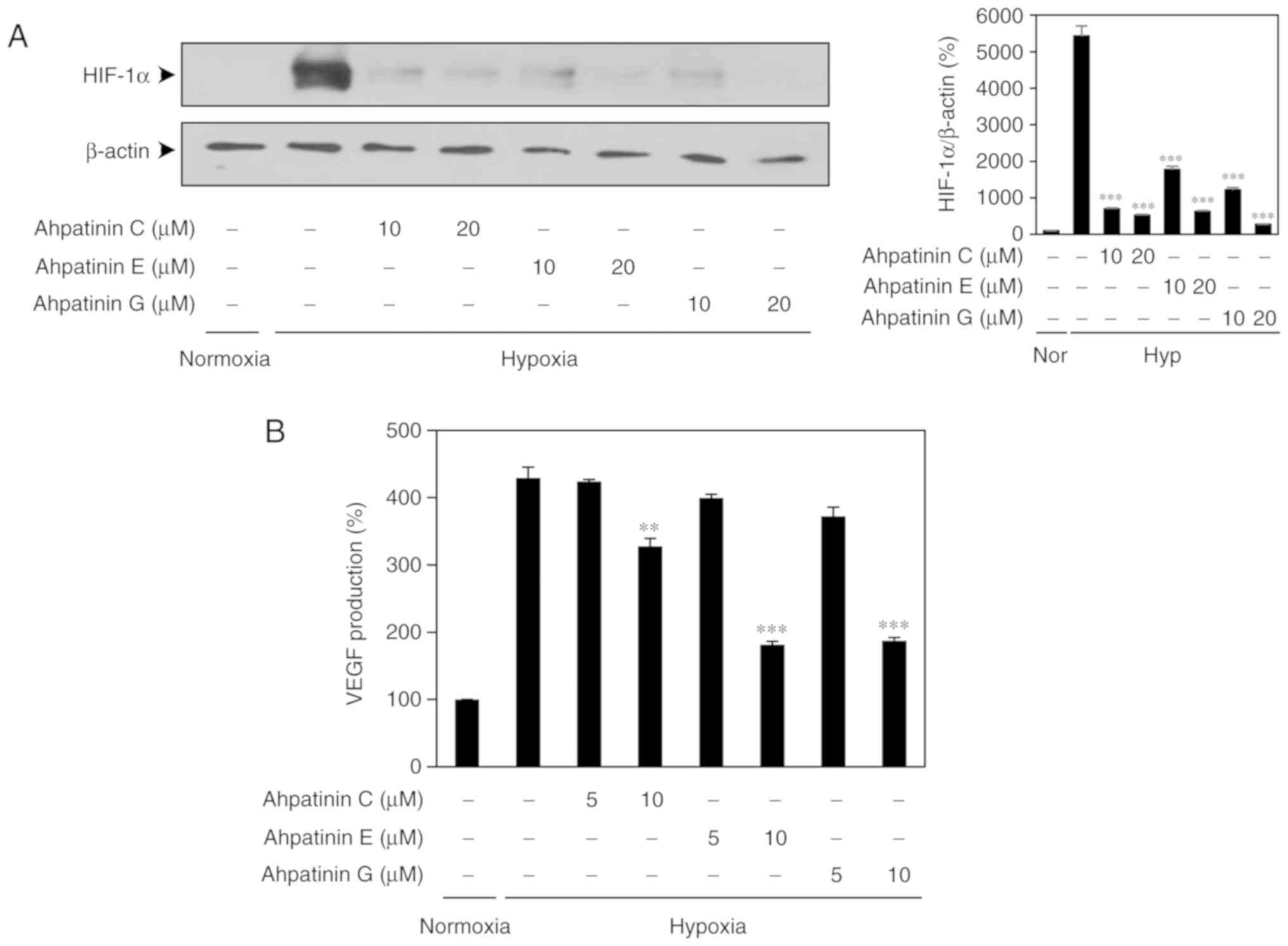|
1
|
Ellis LM, Liu W, Ahmad SA, Fan F, Jung YD,
Shaheen RM and Reinmuth N: Overview of angiogenesis: Biologic
implications for antiangiogenic therapy. Semin Oncol. 28 (5 Suppl
16):S94–S104. 2001. View Article : Google Scholar
|
|
2
|
Carmeliet P and Jain RK: Molecular
mechanisms and clinical applications of angiogenesis. Nature.
473:298–307. 2011. View Article : Google Scholar : PubMed/NCBI
|
|
3
|
Weis SM and Cheresh DA: Tumor
angiogenesis: Molecular pathways and therapeutic targets. Nat Med.
17:1359–1370. 2011. View
Article : Google Scholar : PubMed/NCBI
|
|
4
|
Wang Y, Li JX, Wang YQ and Miao ZH:
Tanshinone I inhibits tumor angiogenesis by reducing STAT3
phosphorylation at TYR705 and hypoxia-induced HIF-1α accumulation
in both endothelial and tumor cells. Oncotarget. 6:16031–16042.
2015.PubMed/NCBI
|
|
5
|
Jain RK: Antiangiogenesis strategies
revisited: From starving tumors to alleviating hypoxia. Cancer
Cell. 26:605–622. 2014. View Article : Google Scholar : PubMed/NCBI
|
|
6
|
Loges S, Schmidt T and Carmeliet P:
Mechanisms of resistance to anti-angiogenic therapy and development
of third-generation anti-angiogenic drug candidates. Genes Cancer.
1:12–25. 2010. View Article : Google Scholar : PubMed/NCBI
|
|
7
|
Ferrara N, Gerber HP and LeCounter J: The
biology of VEGF and its receptors. Nat Med. 9:669–676. 2003.
View Article : Google Scholar : PubMed/NCBI
|
|
8
|
Karkkainen MJ and Petrova TV: Vascular
endothelial growth factor receptors in the regulation of
angiogenesis and lymphangiogenesis. Oncogene. 19:5598–5605. 2000.
View Article : Google Scholar : PubMed/NCBI
|
|
9
|
Kowanetz M and Ferrara N: Vascular
endothelial growth factor signaling pathways: Therapeutic
perspective. Clin Cancer Res. 12:5018–5022. 2006. View Article : Google Scholar : PubMed/NCBI
|
|
10
|
Sachdev JC and Jahanzeb M: Evolution of
bevacizumab-based therapy in the management of breast cancer. Clin
Breast Cancer. 8:402–410. 2008. View Article : Google Scholar : PubMed/NCBI
|
|
11
|
Salter JT and Miller KD: Antiangiogenic
agents in breast cancer. Cancer Invest. 25:518–526. 2007.
View Article : Google Scholar : PubMed/NCBI
|
|
12
|
Abhinand CS, Raju R, Soumya SJ, Arya PS
and Sudhakaran PR: VEGF-A/VEGFR2 signaling network in endothelial
cells relevant to angiogenesis. J Cell Commun Signal. 10:347–354.
2016. View Article : Google Scholar : PubMed/NCBI
|
|
13
|
Jiang BH and Liu LZ: PI3K/PTEN signaling
in angiogenesis and tumorigenesis. Adv Cancer Res. 102:19–65. 2009.
View Article : Google Scholar : PubMed/NCBI
|
|
14
|
Koch S, Tugues S, Li X, Gualandi L and
Claesson-Welsh L: Signal transduction by vascular endothelial
growth factor receptors. Biochem J. 437:169–183. 2011. View Article : Google Scholar : PubMed/NCBI
|
|
15
|
Karar J and Maity A: PI3K/AKT/mTOR pathway
in angiogenesis. Front Mol Neurosci. 4:512011. View Article : Google Scholar : PubMed/NCBI
|
|
16
|
Gomes E and Rockwell P: p38 MAPK as a
negative regulator of VEGF/VEGFR2 signaling pathway in serum
deprived human SK-N-SH neuroblastoma cells. Neurosci Lett.
431:95–100. 2008. View Article : Google Scholar : PubMed/NCBI
|
|
17
|
Olsson AK, Dimberg A, Kreuger J and
Claesson-Welsh L: VEGF receptor signalling-in control of vascular
function. Nat Rev Mol Cell Biol. 7:359–371. 2006. View Article : Google Scholar : PubMed/NCBI
|
|
18
|
Kyosseva SV: Mitogen-activated protein
kinase signaling. Int Rev Neurobiol. 59:201–220. 2004. View Article : Google Scholar : PubMed/NCBI
|
|
19
|
Noort AR, van Zoest KP, Weijers EM,
Koolwijk P, Maracle CX, Novack DV, Siemerink MJ, Schlingemann RO,
Tak PP and Tas SW: NF-κB-inducing kinase is a key regulator of
inflammation-induced and tumour-associated angiogenesis. J Pathol.
234:375–385. 2014. View Article : Google Scholar : PubMed/NCBI
|
|
20
|
Risau W: Mechanisms of angiogenesis.
Nature. 386:671–674. 1997. View
Article : Google Scholar : PubMed/NCBI
|
|
21
|
Moulder JE and Rockwell S: Tumor hypoxia:
Its impact on cancer therapy. Cancer Metastasis Rev. 5:313–341.
1987. View Article : Google Scholar : PubMed/NCBI
|
|
22
|
Jubb AM, Buffa FM and Harris AL:
Assessment of tumour hypoxia for prediction of response to therapy
and cancer prognosis. J Cell Mol Med. 14:18–29. 2010. View Article : Google Scholar : PubMed/NCBI
|
|
23
|
Avni R, Cohen B and Neeman M: Hypoxic
stress and cancer: Imaging the axis of evil in tumor metastasis.
NMR Biomed. 24:569–581. 2011.PubMed/NCBI
|
|
24
|
Bernardes N, Seruca R, Chakrabarty AM and
Fialho AM: Microbial-based therapy of cancer: Current progress and
future prospects. Bioeng Bugs. 1:178–190. 2010. View Article : Google Scholar : PubMed/NCBI
|
|
25
|
Jang JP, Han JM, Jung HJ, Osada H, Jang JH
and Ahn JS: Anti-angiogenesis effects induced by octaminomycins A
and B against HUVECs. J Microbiol Biotechnol. 28:1332–1338. 2018.
View Article : Google Scholar : PubMed/NCBI
|
|
26
|
Jang JP, Jung HJ, Han JM, Jung N, Kim Y,
Kwon HJ, Ko SK, Soung NK, Jang JH and Ahn JS: Two cyclic
hexapeptides from penicillium sp. FN070315 with antiangiogenic
activities. PLoS One. 12:e01843392017. View Article : Google Scholar : PubMed/NCBI
|
|
27
|
Omura S, Imamura N, Kawakita K, Mori Y,
Yamazaki Y, Masuma R, Takahashi Y, Tanaka H, Huang LY and Woodruff
HB: Ahpatinins, new acid protease inhibitors containing
4-amino-3-hydroxy-5-phenylpentanoic acid. J Antibiot (Tokyo).
39:1079–1085. 1986. View Article : Google Scholar : PubMed/NCBI
|
|
28
|
Sun Y, Takada K, Nogi Y, Okada S and
Matsunaga S: Lower homologues of ahpatinin, aspartic protease
inhibitors, from a marine Streptomyces sp. J Nat Prod.
77:1749–1752. 2014. View Article : Google Scholar : PubMed/NCBI
|
|
29
|
Hu L, Roth JM, Brooks P, Luty J and
Karpatkin S: Thrombin up-regulates cathepsin D which enhances
angiogenesis, growth, and metastasis. Cancer Res. 68:4666–4673.
2008. View Article : Google Scholar : PubMed/NCBI
|
|
30
|
Morjen M, Honoré S, Bazaa A,
Abdelkafi-Koubaa Z, Ellafi A, Mabrouk K, Kovacic H, El Ayeb M,
Marrakchi N and Luis J: PIVL, a snake venom kunitz-type serine
protease inhibitor, inhibits in vitro and in vivo angiogenesis.
Microvasc Res. 95:149–156. 2014. View Article : Google Scholar : PubMed/NCBI
|
|
31
|
Drewes CC, Dias RY, Hebeda CB, Simons SM,
Barreto SA, Ferreira JM Jr, Chudzinski-Tavassi AM and Farsky SH:
Actions of the kunitz-type serine protease inhibitor amblyomin-X on
VEGF-A-induced angiogenesis. Toxicon. 60:333–340. 2012. View Article : Google Scholar : PubMed/NCBI
|
|
32
|
Zhu M, Li B, Wang J and Xiao R: The
anti-angiogenic activity of a cystatin F homologue from the buccal
glands of lampetra morii. Mar Drugs. 16:E4772018. View Article : Google Scholar : PubMed/NCBI
|
|
33
|
Hass TL: Endothelial cell regulation of
matrix metalloproteinases. Can J Physiol Pharmacol. 83:1–7. 2005.
View Article : Google Scholar : PubMed/NCBI
|
|
34
|
Bergers G and Benjamin LE: Tumorigenesis
and the angiogenic switch. Nat Rev Cancer. 3:401–410. 2003.
View Article : Google Scholar : PubMed/NCBI
|
|
35
|
André T, Chastre E, Kotelevets L, Vaillant
JC, Louvet C, Balosso J, Le Gall E, Prévot S and Gespach C: Tumoral
angiogenesis: Physiopathology, prognostic value and therapeutic
perspectives. Rev Med Interne. 19:904–913. 1998.(In French).
View Article : Google Scholar : PubMed/NCBI
|
|
36
|
Badewiijns MM, van Vlodrop IJ, Vermeulen
PB, Soetekouw PM, van Engeland M and de Bruïne AP: VHL and HIF
signalling in renal cell carcinogenesis. J Pathol. 221:125–138.
2010. View Article : Google Scholar : PubMed/NCBI
|
|
37
|
Forsythe JA, Jiang BH, Iyer NV, Agani F,
Leung SW, Koos RD and Semenza GL: Activation of vascular
endothelial growth factor gene transcription by hypoxia-inducible
factor 1. Mol Cell Biol. 16:4604–4613. 1996. View Article : Google Scholar : PubMed/NCBI
|
|
38
|
Lim HN, Jang JP, Han JM, Jang JH, Ahn JS
and Jung HJ: Antiangiogenic potential of microbial metabolite
elaiophylin for targeting tumor angiogenesis. Molecules.
23:E5632018. View Article : Google Scholar : PubMed/NCBI
|
|
39
|
Yoshida H, Okamoto K, Iwamoto T, Sakai E,
Kanaoka K, Hu JP, Shibata M, Hotokezaka H, Nishishita K, Mizuno A
and Kato Y: Pepstatin A, an aspartic proteinase inhibitor,
suppresses RANKL-induced osteoclast differentiation. J Biochem.
139:583–590. 2006. View Article : Google Scholar : PubMed/NCBI
|
|
40
|
Liaudet-Coopman E, Beaujouin M, Derocq D,
Garcia M, Glondu-Lassis M, Laurent-Matha V, Prébois C, Rochefort H
and Vignon F: Cathepsin D: Newly discovered functions of a
long-standing aspartic protease in cancer and apoptosis. Cancer
Lett. 237:167–179. 2006. View Article : Google Scholar : PubMed/NCBI
|
|
41
|
Trincheri NF, Nicotra G, Follo C, Castino
R and Isidoro C: Resveratrol induces cell death in colorectal
cancer cells by a novel pathway involving lysosomal cathepsin D.
Carcinogenesis. 28:922–931. 2007. View Article : Google Scholar : PubMed/NCBI
|
|
42
|
Zhang J, Zhao P, Fu Z, Chen X, Liu N, Lu
A, Li R, Shi L, Pu P, Kang C and You Y: Glioma cells enhance
endothelial progenitor cell angiogenesis via VEGFR-2, not VEGFR-1.
Oncol Rep. 20:1457–1463. 2008.PubMed/NCBI
|
|
43
|
Liang X, Xu F, Li X, Ma C, Zhang Y and Xu
W: VEGF signal system: The application of antiangiogenesis. Curr
Med Chem. 21:894–910. 2014. View Article : Google Scholar : PubMed/NCBI
|















